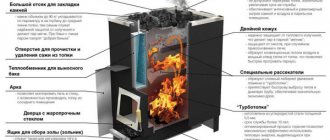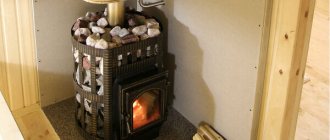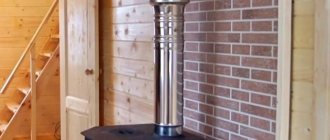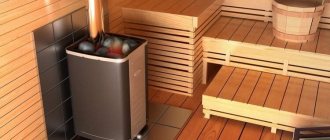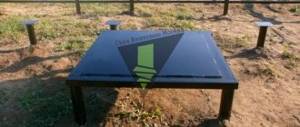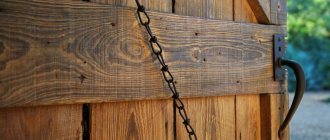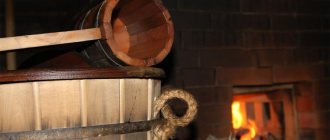How wood stoves work
The operating principle of these heating devices is based on the classic stove heating, but is complemented by a more rational and efficient mechanism for converting fuel into energy. The installation of a wood-burning stove for residential buildings and baths allows you to achieve maximum energy efficiency at low fuel costs.
Long-burning stoves are made, as a rule, from cast iron or thick sheets of steel, which retain heat well inside the stove and the house without releasing it into the chimney. Less often they are made on the basis of bricks. The choice of unit must be planned already when developing a project for a house, bathhouse, workshop, warehouse or other room that will need to be heated. This will allow you to use the capabilities of heating devices most efficiently.
Heating stove made of bricks by Sergei Mikhailov drawings
A diagram of the next furnace is shown in IMAGE 2.
A - general draft valve, B - stove, C - front view of the chimney section, D - fire door, D - exit to the first well from the firebox (hilo), E - side view of the chimney section, F - firebox, I - stove, K - Hailo, L - side view of the cross-section of the stove firebox.
A heating stove with horizontal smoke wells is good because it does not require clear and strict fixed markings at the chimney outlet. In ancient times, such markings could only be carried out by a senior furnace master. Laying the first row and marking the foundation was never trusted to apprentices
The reason for this strict subordination was not formality, but the importance of making a fatal mistake
The main advantages of a furnace with horizontal wells:
- Does not require precise calculation when marking the first row.
- It warms up evenly (the hottest parts of the stove, which allow for intensive heat removal, will be located at the bottom, and the less hot ones will gradually move to the upper zone of the room that is heated).
- Cools down evenly (heat from the lower rows of the stove will gradually be transferred to the upper rows). The period of furnace cooling and intense heat transfer is the same period, which is measured in several hours. This is another advantage of a stove with horizontally located smoke channels.
- Allows arched dryers to be built into the stove masonry without any problems.
There are other auxiliary drawings and diagrams of the furnace by Sergei Mikhailov:
- Sergei Mikhailov’s stove with a built-in niche-dryer in a side section shows IMAGE 3, where A is a valve, B is a door for cleaning, C is a dryer, D is another door for cleaning, D is a high-rise, E is a side view of a section of a smoke well.
- Schemes of wells, winter and summer options, are shown in a side section by IMAGE 4, where A is a valve for winter, B is a valve for summer, C is high.
Construction and arrangement of wood-burning stoves
- cylindrical body for burning fuel;
- chimney with a diameter of 100 mm or more;
- a piston for supplying air to the combustion chamber;
- a valve in the upper part to regulate the flow of incoming air;
- cover with a hole for the piston pipe.
The design of long-burning wood stoves has its own characteristics. The mechanism of their action is based on gas generation or, in simpler terms, smoldering, achieved through a constant controlled air flow. The heat generated by the stove is evenly and gently distributed throughout the room due to the built-in heater. The outer walls of the heating device only reach a safely permissible temperature level.
Design and principle of operation of a wood-burning stove
Structural elements of a wood stove
The modern type of wood-burning heaters consists of a chamber for storing fuel, cast iron grates, an ash pan for collecting residual wood, and a chimney for removing residual gases. The lumber is placed in the fuel compartment and set on fire. The combustion reaction promotes the formation of gases with high temperatures. They, moving through the pipe, heat the walls of the device, which release heat into the room. The heating rate depends on the housing material.
To support the fire in the combustion chamber, a blower flap and a smoke valve are used. They are opened to a larger or smaller size. When excess air enters, the heat transfer of the structure decreases, and soot quickly appears in the chimney.
A standard stove will heat a house or cottage in an average of 5 hours.
Installation
You can install a wood-burning stove in a bathhouse and even a house yourself, or you can order a service from a company that professionally designs bathhouses, houses and technical premises.
Main working areas:
- fuel loading area;
- ash collection;
- area of combustion of pyrolysis gas.
Installing wood-burning stoves in bathhouses is very popular. They are able to heat the room very quickly and maintain the required temperature for a long time. Even in very cold times, this only takes about half an hour.
At the top of the stove, where the wood smolders, there is an air distributor that regulates the intensity of the flow of fuel to maintain optimal operating conditions. The firewood smolders from above and is also lit from above. This makes it possible to achieve the release of pyrolysis gases, which are also capable of burning and releasing heat. This operating mechanism allows you to obtain additional heat from one volume of fuel.
Wood heating stove location
The best position for a wood-burning stove for a home is on the wall opposite the entrance.
In this case, the largest amount of fresh, oxygen-rich air will enter the firebox.
To distribute heat evenly in the room, it is better to install the stove in the middle of the wall, but this is done if the room is spacious enough.
In cramped conditions, the heat generator has to be moved to the least needed area - to the corner. This technique is very common and every stove manufacturer will definitely have a couple of units in the corner design in their model range. By the way, this arrangement has one more advantage: a corner stove can heat not one, but two adjacent rooms.
When choosing a location for the stove, keep in mind that it can be quite heavy. Due to their heavy weight, brick ovens are built on a separate foundation, so building such an object in a ready-made house is not always possible.
A powerful cast-iron wood-burning stove for the home will also be quite heavy. For it, you will also have to build a reinforced concrete foundation resting directly on the ground. The dimensions of such a pedestal should exceed the dimensions of the furnace by approximately 100 - 150 mm on each side.
Steel stoves, like low-power cast iron ones, are installed on a thick steel sheet, which serves to evenly distribute the load on the floor.
Cast iron fireplace stove installed in the house
When placing a wood-burning stove in a wooden building, fire protection measures should be taken:
- All oven elements that heat up to high temperatures during operation should be covered with fire-resistant heat-insulating material.
- The chimney at the intersection of enclosing structures - floors, walls - must also be insulated. Liners are installed in brick chimneys, thus reducing the heating temperature of the masonry.
Sandwich-type chimneys, as well as ceramic ones, are considered a good option for a wooden house.
- A sheet of steel, asbestos or other fire-resistant material must be laid on the floor in front of the firebox.
- The wall next to which the heating device is mounted must be lined with non-combustible material - most often it is covered with ceramic tiles.
The location of the furnace, equipped with a water circuit and connected to the heating system, is influenced by the method of circulation of the coolant. In gravity systems, where the working medium moves only due to convection (without the use of a pump), they try to place the heat generator below the radiators, usually in the basement or semi-basement. If the coolant circulation is forced, that is, with the assistance of a pump, then the furnace can be located at any level.
If the house is two-story and stoves are installed on the lower and upper floors, each of them is equipped with its own chimney.
Chimney
An important part of the stove design is the chimney and connecting pipes. Installation of wood-burning stoves both in houses and in bathhouses requires special care and precision. The process of installing a chimney is especially complicated. Therefore, the features of installing a stove should be thought through at the stage of building houses.
In general, the design of the stove is simple, due to which it operates for the longest possible service life, is easy to repair and is easy to maintain.
Types of Russian stoves
Russian stove with fireplace
Modern versions of Russian stoves include a variety of designs for heating and cooking. The choice of model depends on the purpose, features of use and requirements for the device.
The classic model with a bed allows you to arrange an additional bed that can accommodate up to three people. Modern models are designed for one adult or two children's seats.
An oven with a stove, which is built into the structure, allows you to cook food. Often such options are accompanied by the installation of a large hob, oven and heating.
A model with a stove and a bench is suitable for a country house. The design has a large sleeping area and a stove for cooking. The hob can be anything - it all depends on the requirements for the stove.
Mini Russian stoves without a stove bench are used in bathhouses and small kitchens. They may have a different design, but without a sun lounger and plates.
A stove with a fireplace is a more modern option for heating a summer house. Instead of an open cooking chamber, a stylish fireplace is installed, thanks to which you can heat another room through a partition. When using this option, you don’t have to install a second income pipe.
The Russian stove with heating is the oldest of the designs. It contains a crucible. Products for cooking are placed in the chamber, and fuel is placed through the mouth with a partition. With this option you can cook food and heat the room at the same time.
How do wood stoves work?
In a classic stove, wood burns in 1-3 hours. Long-burning heating devices operate on average 6-10 hours. They do not require frequent addition of firewood, retain heat better and do not take oxygen from the air.
The construction of wood-burning stoves for baths is organized on the principle of purposefully blocking the flow of air into the combustion area. Under such conditions, wood under the influence of high temperatures breaks down into a volatile part (pyrolysis gas) and a solid component (coal or coke).
Firewood in the firebox burns much slower and at a higher temperature compared to a conventional stove. This is achieved by loading a large volume of firewood into the firebox with limited air access. Firewood does not burn immediately, but smolders, producing combustible fuel gas, which also effectively participates in heating the room.
It is better to install a chimney for a wood-burning stove installed in a bathhouse or in a house with the help of a specialist, because this is a very labor-intensive and time-consuming process. When installing a chimney, complete tightness of all joints must be observed, and all parts of the system must be properly processed to ensure safe operation of the equipment.
Structurally, the firebox of a long-burning furnace is more spacious and is divided into two parts. In one compartment, firewood smolders, heating the rooms; in the other, dry fuel simply gradually heats up, releasing gas. The combustion process of gases is regulated. Conveniently, you can replenish the firebox at any time while the stove is operating.
Some models are equipped with a water heat exchanger and have an air convection system. In the process of designing a heating system based on a wood-burning sauna, it is necessary to take into account the minimum functionality of the device, which will allow it to cope with specific tasks.
Peculiarities
Wood stoves provide cyclical heating of indoor air, which has a positive effect on health. The cyclical change in temperature has a hardening effect and, according to doctors, such heating is the most favorable for the home.
The main principle of operation of these heating devices is the ability to operate in two modes: rapid heating of the room and long-term burning. The efficiency of furnace operation is achieved through pyrolysis - smoldering of fuel due to the work of gas.
Classification
Long-burning furnaces, depending on the design features, are classified according to the following criteria:
- form,
- size,
- appointment,
- power,
- fuel processing method,
- heat transfer method
- Wall thickness.
The shape of the units is round, rectangular, triangular and angular; by purpose - compact, with economical fuel consumption, increased fuel efficiency, fireplace stoves. There are two types of fuel processing - direct and injection.
Based on the duration of smoldering of the fuel material, furnaces are divided into units with a minimum heating period (up to 4 hours), average (up to 8 hours) and maximum (more than 10 hours). For installation in a bathhouse, home or workshop, the appropriate model of wood-burning stove is selected.
The most popular models are Buleryan, Professor Butakov, Teplodar, etc. Fireplace stoves are in great demand, which, in addition to their heating function, are distinguished by their special external aesthetics. They can be used in residential areas as decorative elements. The fireproof glass door safely covers the flames while allowing you to observe them at the same time.
Chimney installation
Wood-burning stoves are often used in saunas. The simplicity of the design makes it possible to assemble and install such a stove with your own hands. But it is very important to pay due attention to the installation of the chimney. Only with proper organization of the chimney can you be sure of fire safety.
Problems with chimneys of long-burning stoves arise due to their high efficiency. All the heat is transferred to the room, rather than going out into the chimney. In this case, the burnt gases condense on the inner walls of the pipe and flow down. This condensate, at the slightest cracks at the joints of pipes, can escape to their outer side, which leads to the appearance of an unpleasant odor and spoils the appearance of the device. To avoid such problems, at the design stage of houses and baths, all the features of the premises and the internal architecture of the space are taken into account to create the optimal shape and design of the chimney.
Principles of chimney installation
- “According to smoke” - the upper links of the pipes are put on the lower ones so that the smoke does not experience resistance from the joints as it moves. Such installation is acceptable for primitive furnaces and only if there is a special sump to collect condensate.
- “By condensate” is the optimal type of installation for long-burning furnaces. In this case, the upper section of the pipe is inserted into the lower one to allow condensate to flow down. This eliminates the possibility of condensation passing out. All liquid enters a special sump and burns in the oven.
Stove chimney
It performs several functions at once: removing smoke to the street, providing draft and organizing heat exchange between flue gases and the “body” of the stove. It has a heat exchange and output parts.
Typically, ordinary people refer to a chimney as a pipe on the roof of a house. However, in the language of stove manufacturers, the concept of a chimney also includes the pipe that comes directly from the device.
In the photo: the BREVIERE model from the Cheminees Philippe factory.
The task of the heat exchange part of the chimney is to ensure that the heated flue gases, on the way to the chimney, come into contact with the maximum area of the masonry inside the stove. This will allow the walls to “absorb” the greatest amount of heat. There are several ways to increase the heat-receiving area. One of them is the device of a brick bag (cap). Gases enter it through a hole in the roof of the firebox, linger there, and then exit into the chimney. Another way is to create a flue system. A complex system of interconnected smoke channels is organized in the “body” of the furnace. Gases pass through them before entering the outlet of the chimney or pipe. Such channels exist in both brick and finished stoves made in production (potbelly stoves, heaters).
The second part - the pipe - not only removes smoke to the street, but also serves to organize draft. Channels or caps in the heat exchange part significantly slow down the passage of air flow, so very high demands are placed on the chimney. Its correct calculation requires engineering knowledge and experience. But with proper installation of the chimney, the efficiency of the stove will be at least 60%.
What to look for when purchasing
When purchasing a heating device, first of all, you need to pay attention to its power. This is a key characteristic that affects performance. To be sure, you can order a calculation of the power of a wood-burning stove for a bathhouse from specialists on the eve of purchase.
In addition, it is equally important to choose the right oven size. If the size of the stove is too large for the room, then it will overheat and fuel will be wasted. The choice of stoves is very large, so it is possible to select the optimal equipment for absolutely any type and size of premises.
Before choosing a stove, you need to find out the area of the potentially heated room and decide on the required set of technical characteristics. Using different models of stoves, it is possible to heat rooms with an area of 80-250 m2.
This type of units, in addition, has two varieties. The first is used exclusively for heating the room. The second model is more functional and, in addition to heating the air, provides the ability to cook food.
The simplest models are very affordable in cost. More complex models with advanced functionality vary in price and can be quite expensive. Therefore, you need to know which features are needed so as not to overpay for unused features.
Features of creating a compact oven
To get high-quality room heating in your home, you just need to build a compact brick stove with your own hands in accordance with the project. At the same time, in such a design you can place all the necessary additions : a cast-iron hob, a drying box and even a container for heating water.
This design is built with walls that effectively heat the heated room. The heating system will be of a grassroots nature, which, based on practice, is considered the most effective for heating small houses up to 50 square meters. As the parameters of the living space increase, the dimensions of the brick kiln also increase proportionally.
Before proceeding with the construction of a stove for a brick house, you need to prepare an appropriate project. Fortunately, you won’t have to draw anything yourself, since the information can be found in printed publications or electronically. The correct construction of the furnace structure will affect the efficiency of the equipment , as well as its service life.
Advantages of wood stoves
- do not require the construction of a foundation,
- compact, light in weight,
- have high efficiency (up to 85%),
- economical in fuel consumption,
- allow the use of not only firewood, but also coal or pellets,
- suitable for work in all types of premises,
- Many models have a modern design and fit well with almost any interior.
- many types of long-burning stoves do not operate on liquid fuel,
- have a complex setup system,
- create condensation
- require supervision during operation.
In general, long-burning stoves are the best option for economical and high-quality heating of a country house, bathhouse and any technical premises.
What can be useful for doing the work yourself?
Before starting the construction of a brick heating and cooking stove in a country house, you need to prepare the tool. To perform quality bricklaying, you will need the following things:
- construction trowel;
- rubber or wooden hammer;
- water level and plumb line;
- building code;
- metal hammer with a sharp edge;
- construction tape for taking measurements.
If we consider the necessary consumables, then first of all you will need fireclay bricks. To mix the solution, you will have to stock up on fine sand and high-quality clay. At the same time, it will not be possible to build a brick stove device with your own hands if you do not have the following products:
- metal corners;
- firebox door;
- blower door;
- cast iron hob with the required number of burners;
- view-type gate valves;
- if necessary, an oven and a water heating tank.
The sand-clay mixture should be mixed to a fairly thick consistency.
But according to the recommendations of experienced stove makers, it is advisable to first check the solution for quality. There are several ways to do this. Several balls are rolled from the prepared construction mixture, which are left alone until completely dry. After this, they are checked for the presence or absence of cracks. If no cracks were found, then proceed to the next stage of testing. To do this, a dry workpiece is thrown onto a concrete base from a meter height. If the ball has crumbled, then you need to change the proportions of the clay mortar , but if not, then you can proceed to laying bricks.
But in order to finally ensure the quality of the mortar, the workpieces are tested by fire. For this purpose, the balls are placed in the oven and baked for several hours. A high-quality sand-clay mixture does not allow the workpieces to collapse under the influence of high temperatures. It is this solution that can guarantee the reliability of a brick stove in the future.




